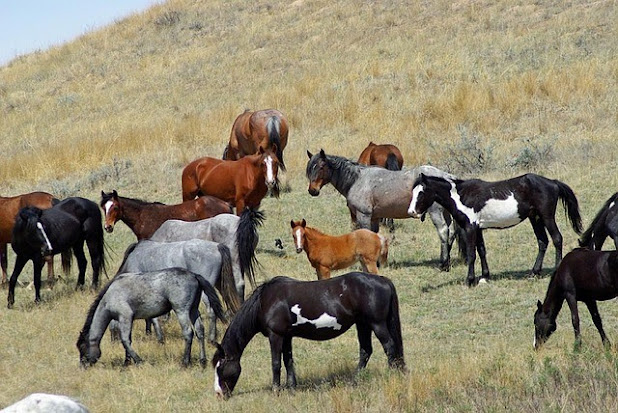20 Most Common Horse Coat Colors
Horses come in so many different colors! And each color is very unique in it's own way, here are 20 most common horse coat colors:
#1. Bay. Bay is the most common color since it is actually the base color of all colors. Bays have black points and a black mane and tail.
#2. Black. A real black horse will have brown eyes, black skin and their coat will be fully black, that means no white markings or spots anywhere. There are actually two different types of black however. There is Fading black and Non-fading black. Fading black is where the horse's black coat has areas where the black goes a little brown. This is usually caused by if the black horse is always in the direct sunlight. Non-fading black horses' coats will have a blue tinge to the black that does not fade in the sun.
#3. Chestnut. This color can range from light or sorrel to liver dark chestnut.
#4. Dun. Dun horses have a distinctive black dorsal stripe that goes across the horse's back, length ways.
#5. Buckskin. This color is very similar to dun. Although there is no dorsal stripe.
#6. Palomino. The base coat of palominos can range from a pale, pastel yellow color to a rich gold. Heres a fun fact about palominos, palomino colored horses actually originated in the desert! And, if palomino horses are fed on a high protein diet, dapples will eventually appear in their coat!
#7. Grey. And no, greys are not actually "grey." Grey is referred to a horse that is actually white, (sometimes super super light grey) but with black points. So black around the muzzle, nose and eyes. This color is quite rare.
#8. Roan. Roan pattern, also called as varnish, is characterized by white hair coming up through the base color coats. There are two different types of roan. Red roan and blue roan. Red roan has a chestnut base color with white hairs mixed in and some red or dark red/brown coloration. Blue roan has a dark base color with white hairs mixed in with dark points and black undertones. The dark base color almost looks like it's blue-ish.
#9. Pinto. Pinto horses look like someone has splashed white paint over its colored coating, or someone painted the white base with other colors. The white is the base color and because of some passed down genetics, the brown or black patches didn't fully cover the whole body. So basically, ever pinto horse has a white base coat, then the other color, whether that's bay or black or palomino or even dark grey, just haven't covered the white fully.
#10. Dark bay. Dark bay horses are like bays, except that their base color is much darker than normal bays. Therefor, dark bays seem to have a black-bay coat.
#11. Sorrel. Sorrel is simply a light shade of chestnut, but it's red-ish hue makes it distinct.
#12. Cremello. This color is very light, usually white, but with light pink points and unique bright blue or rarely amber-colored eyes.
#13. Cream. The cream color comes from the “cream” gene, which dilutes the base colors like chestnut, bay, and black. When it weakens the palomino or buckskin color in it, it gets even lighter.
#14. Dapple grey. Dapple gray has a gray base with white marks splattered throughout the coat. If a dapple gray has black points, you can call it blue roan as well.
#15. Grullo. Grullo horses have Dun overlay on black, mousy color, and it has a dorsal stripe, with zebra stripes (bars) on the legs, or a mask (dark face).
#17. Skewbald. Skewbald is the term used to describe a horse of any color other than black that showcases overo or tobiano pattern or a combination of the two (tovero).
#18. Piebald. It is a horse that has black color with overo or tobiano pattern or tovero (a spotted blend of overo and tobiano).
#19. Tobiano. This color features a spotted color pattern with white hair and pink skin patches in its base coat color. It is commonly seen in Pinto horses and produced by a dominant gene. You can identify tobianos because it doesn’t have extreme facial white; instead, it has a solid-colored head and white legs.
#20. Brown. Brown horses showcase a dark brown coat or dark seal color, with black points in its lower legs, tail, and mane, and a lighter brown or reddish tan areas around the eyes, muzzle, behind the elbows and in front of the stifle.























Comments
thnx 4 post.